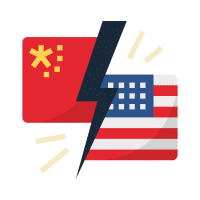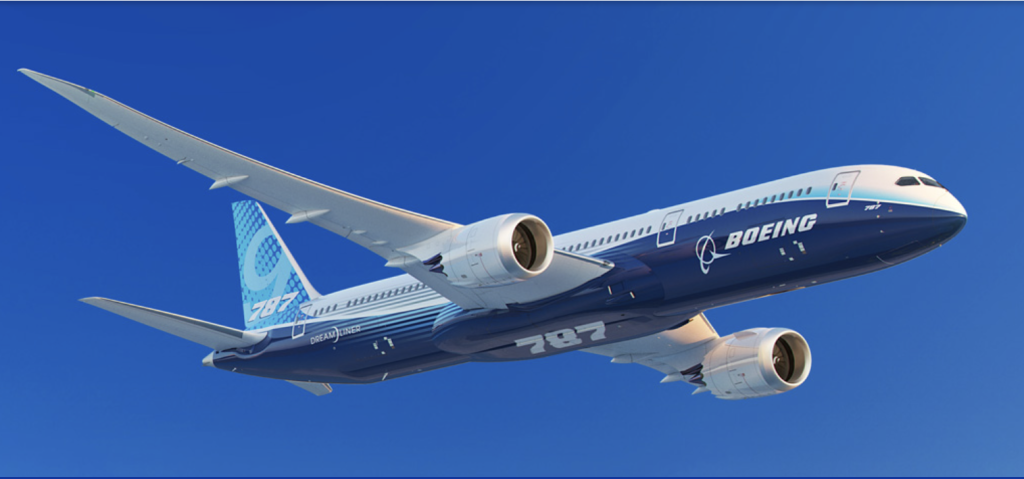On Drones and Dreamliners: Analyzing Dissimilar Outcomes of Made in China 2025 through a comparison of UAV and Passenger Aircraft industries
- Analysis
 China-Focus-Editor
China-Focus-Editor- 08/13/2025
- 0

Source: Boeing website
[The China Focus at The Carter Center, in cooperation with the China Focus at the University of California, San Diego, and the 1990 Institute, organized an essay contest in honor of President Jimmy Carter. This essay, by Parvathy Sailesh & Chenling Wan of National University of Singapore, received The 1990 Institute Prize-Runner Ups. Read more HERE.]
Introduction
Ancient Chinese wisdom advises 不进则退 (bù jìn zé tuì) – to stand still is to fall behind. Beijing’s economic philosophy aligns with this thought. It recognizes that China cannot sustain its impressive economic trajectory of the past two decades by remaining the world’s factory for low-value-added goods built mostly from non-indigenous technology. Launched in 2015, the Made in China 2025 initiative (MIC25) channels state-led investments into innovation, aiming to transform the country from manufacturer of low-end goods to a global tech leader across ten advanced industries.1 With the approach of its target year and the escalating tariff wars between US and China, MIC25 is once again drawing international attention. In its early years, MIC25’s heavy state intervention and explicit targets for market share and production provoked international skepticism and triggered sanctions. Yet, ten years since its introduction, the initiative is widely regarded as a successful project in industrial policy, achieving (and often exceeding) its goals despite trade barriers and technology transfer restrictions.
However, there are wide differences in the success achieved by MIC25, even within sectors. For instance, consider aerospace and aviation, a sector that includes two very different industries – Unmanned Aerial Vehicles (UAVs) or drones, and passenger aircraft. In Shenzhen today, over 1700 drone manufacturers produce output worth 13.41 billion USD a year.2 The city has witnessed the rapid rise of market leaders like DJI, which in less than a decade has grown to serve over 77% of global drone demand by 2021.3 Nine hundred miles away in Shanghai, home-grown passenger airplanes have recently lifted off the proverbial runway, but struggle to gain cruising altitude in the market. China’s large‑aircraft manufacturing is concentrated in a single state‑owned enterprise: COMAC. Established in 2008, COMAC has developed three aircraft models, the first of which made its maiden commercial flight in 2017. It has scaled up production since, and generates an annual revenue of over 1 billion USD. 4 As of 2025, COMAC plans to invest 1.36 billion USD annually for R&D in Shanghai.5 However, the passenger aircraft sector has fallen short of indigenization, delivery timeline, and market share targets set for it in the MIC25 document. The goal was to capture 10% of the domestic market share by 2025, but so far only 162 aircraft are in service, certified in two countries – China and Indonesia. COMAC has faced many obstacles in developing a truly indigenous aircraft – its current designs rely largely on imported components.
Why did the drone industry exceed the targets set under the plan, and why did commercial aviation not? The answer lies not only in the nature of these industries, but also in the institutional mechanisms behind the implementation of MIC25. We compare these two industries to unravel the factors that shape the outcomes of MIC25.
One sector, two industries with different results
China’s ambitions in making jetliners domestically, have a long history. Initially, the economy had a nascent industry that assembled aircraft domestically based on models leased from other regions. For instance, the Xian H-6 manufactured in China was designed after the Tupolev Tu-16. Attempts to indigenously develop an aircraft in the 1970s and 80s led to the Shanghai Y-106. But, only seven units were made before the Y-10 project was shelved to a range of reasons including budget constraints and insufficient market, failure to meet international airworthiness standards7, and shift in production priorities8.
COMAC began operations in 2008 with an initial capital of 2.7 billion USD. While the exact financial information about COMAC is not disclosed publicly, experts estimate that it has received 49 billion USD in investment as of 2020, a majority of which comes from state-owned entities.9 Despite the enormous state funding and international attention (including the US pondering sanctions on the sale of parts to COMAC), it has not developed technological or manufacturing capacity that is comparable to lower tier firms in the field (like the Russian Ilyushin or Tupolev, let alone the top players like Boeing or Airbus). They have a solid safety record, but are yet to receive many international certifications.10
Chinese media also cites expected multiplier effects from the long backward linkages in the aircraft supply chain which generate technology, capital, and knowledge spillovers. Today, China ranks as the world’s second-largest passenger aviation market by seats sold, trailing only the United States.11 These reasons add impetus to MIC25’s efforts to indigenize aircraft production.
In the younger UAV (drone) industry, the Chinese economy has made exponential gains – in both production and innovation. China is the largest player in the UAV market today, with a total of over 14,000 drone-makers12 generating an estimated revenue of over 9 billion USD13. The leading firm DJI alone generated 2.7 billion USD in global sales as early as in 201714. The market is expected to see a 5% year-on-year growth rate in 202615, owing to both globally competitive technology and immense manufacturing capabilities. The tech advancement in the past decade is also nothing short of impressive. In 2018, remotely controlled passenger drones clocked 130 kmph with a range of 80 miles16. Chinese firms perfected the electric vertical take-off and landing (eVOTL) technology – a game-changer in the drone industry. Apart from tax breaks, subsidies and other monetary incentives, the government has used other policy tools like approving 17 “UAV pilot zones” to encourage drone use and innovation17.
What sets the supply chains of UAVs and Passenger Aircraft apart?
Drones are the perfect sector where China’s manufacturing advantage in compact electronics were skillfully converted to a tech advantage. Firms essentially took the electronics behind smartphones and integrated this technology to a different vertical.
Shenzhen offers a unique advantage for drone makers – it already has a wide manufacturing base in place, producing components they need. Drone makers also have a very fast organisational architecture – an engineer can develop a design and get the prototype made in a workshop attached to the lab within the same day18. This quick innovation is behind the remarkable speed at which Chinese drones have progressed. This deep ecosystem of manufacturing networks in Shenzhen made sure that structural factors of the economy did not hinder innovation. A lot of the parts the large aircraft need, are not areas where China already has solid manufacturing ecosystems and technological capabilities in place.
Unlike large airliners, drones have smaller R&D timelines, require smaller investments, and need less coordination among producers of different parts. Aircraft production requires hundreds of industries coordinating to put together carefully designed components. For local governments who compete with each other to report successes in innovation and tangible increases in production, investing in UAV makers is a safer bet on an easy win. During its nascent days, government policy was yet to catch up with the developments in the UAV sector. Governments were still figuring out how a drone policy should look like, and these markets were mostly unregulated – unlike the passenger aircraft market which has been a deeply regulated industry since its earliest days. This made it easier for firms like DJI to capture market shares by selling at lower price points through quick innovation and upscaling. This combination of easy entry, room for scaling up, and fast innovation is what makes the “low-altitude economy” – a popular phrase in China’s industrial policy – the perfect arena for state-guided innovation.
In sectors like robotics, mergers and acquisitions involving foreign firms have aided technology transfer – an important factor behind quick, scaled up production. For instance, Midea acquired Kuka – a german industrial robot producer – in 2016, and the move has boosted their exponential rise in the market for industrial automation19. Outward FDI data also evidence this trend, which has sparked some concerns surrounding intellectual property transfers20. A similar strategy is difficult in the passenger aviation sector, because there are fewer and bigger companies, closely regulated in their home turfs. Besides, UAVs have wide-ranging military applications. This has prompted military R&D investment and subsequent knowledge transfer to the private sector. While dual-use aircraft development has received military attention, the same is not true for passenger aircraft.
There are important demand side factors behind the success disparity among these sectors. The customers composing these two markets are very different from each other. Drones are bought by granular consumers of all types – organizations, militaries, individuals, businesses, etc. Aircraft are bought by large airliners (few, connected customers) who have long standing relations with the existing producers, making it harder for a new entrant like COMAC to break into the market.
Thus, through a combination of the advantages offered by the state-controlled economic structure of China, its historically cultivated comparative advantage and support from state industrial policy, DJI is able to sell drones that match state of the art capabilities at prices that others cannot compete with. The aircraft industry benefits less from the state-led nature of the economy because the manufacturing and supply chain for large aircraft are longer, more technologically advanced, and more reliant on a global supply chain that has been dominated for centuries by the Boeing-Airbus duopoly.
What role does the politico-economic context of industrial policy play?
A key answer to the drone-aircraft disparity lies in the state’s reach over capital flows. Financial markets in China are designed to be used as policy tools21. The country has a notably high household savings rate of 44.3% in 2023, which generates a large capital pool for the economy. The State directs most of these savings into domestic markets maintaining restrictions on investment avenues for households. It thus steers low-interest credit, inexpensive land, and other fiscal incentives like tax breaks to preferred high-tech industries. China’s position as the world’s factory and its large trade surplus has allowed public sector firms to generate profits which are reinvested into the economy. Public investments are channeled in a top-down manner, based on the priorities set by industrial policies like MIC25. This basket of incentives made possible by the state-controlled financial markets enables firms like the drone-makers to sell their products at prices that most international players cannot match. In addition to financial incentives, local governments use clever methods to push companies to innovate, modernize and automate. For example, one local government asked firms in its jurisdiction to submit videos explaining how they can incorporate more robots into the production process22.
Political factors influence the demand side as well. The production of large aircraft is a highly sophisticated and systematic endeavor—one that is deeply entangled with the forces of geopolitics. Evidence suggests that government policy often being an equally if not more important factor than the market globally in determining everything from aircraft types procured to ticket sales23– a concern that in its early days did not apply to UAVs. Large passenger aircraft involve massive purchases — often worth hundreds of millions of dollars — where governments typically exert at least informal influence over procurement decisions. In contrast, UAV purchases are usually smaller in scale and more diversified across different buyers, making them less exposed to direct geopolitical pressures than large aircraft deals.
China’s demographic dividend was the fuel behind its growth in the past two decades – and it is relevant here too. It trains not only engineers and managers, but also talent required for mid-level manufacturing jobs – welders, electricians, niche technicians. On the other hand, rising labour costs, an ageing workforce and global supply‑chain realignment are converging to make automation a strategic imperative for Chinese manufacturing. In 2023 the average wage of a factory worker passed RMB 104,000—a more-than‑doubling in a decade—while the national median age climbed to about 40 years, shrinking the pool of young, low‑cost labour that once underpinned China’s export boom.24 Although worker productivity has increased by 6%, most of this increase comes from capital investment – the Total Factor Productivity (TFP) continues to remain low25. The country also needs to pay attention to the “creative destruction” brought by this change through approaches like simultaneously advancing skills retraining, democratizing access to smart production lines, and providing regional employment safety nets to keep structural unemployment within manageable bounds. While lenient labour laws and long work hours fuel innovation and production, it also casts a veil on the rapid structural shifts in employment that industrial policy brings. Low unionisation and lack of avenues for dissent enable production considerations to take priority despite these shifts.
Conclusion
When studying the wins and losses of MIC25, most analyses compare among the ten sectors rather than within. In this essay, we look at differences in outcomes of two industries under the same broad umbrella – aviation and aerospace. Makers of drones and dreamliners faced very different economic and political contexts. Drone manufacturers were situated in deep manufacturing ecosystems and adapted tech leadership in the small electronics sector to innovate in this new field. Aircraft makers need hundreds of specialised components – and it is near impossible to set up the entire supply chain through industrial policy alone in such a short period. One market is granular, growing, relatively unregulated in its early years while the other is state-influenced across countries, tightly-knit, and historically networked with a small group of existing suppliers. Financial markets are state-steered, investments and industry priorities are centrally set, and rapid automation steps in where the country’s labour force falls short.
The ability of industrial policy to boost the economy if done right is widely recognized in academic circles26. The question is not whether governments should participate in industrial markets, but how they should. This question is especially central to a state-controlled economy like China. China can benefit from playing to its comparative advantage in small electronics, and factoring in market considerations while setting its industrial policy so that information distortion is minimised. But, one must not miss the forest for the trees. MIC25 has indeed transformed the connotation behind the phrase “Made in China” for both drones and dreamliners – which is what it set out to do in the first place.
(The notes in the text are available upon request from the editor.)




